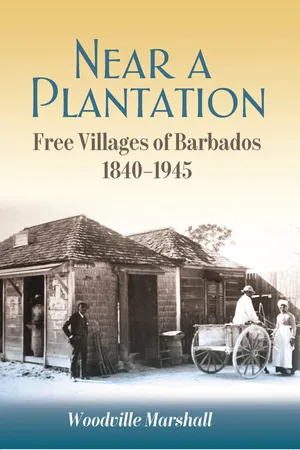
- English
- ePUB (mobile friendly)
- Available on iOS & Android
About this book
In Near a Plantation, Woodville Marshall presents a transformative account of post-slavery Barbados. Through meticulous examination of wills and deeds, Marshall challenges established assumptions, delving deep into the complex dynamics that influenced the lives of former slaves. His exploration offers a comprehensive perspective that reshapes our understanding of how free villages came to be in Barbados.
Marshall’s careful examination reveals the hurdles faced by the formerly enslaved in obtaining land. Plantation owners monopolized land and controlled labour, leaving little opportunity for others. Despite this, some ex-slaves found ways to secure land through negotiation or purchasing from speculators. As the story progresses, we learn about the beginnings of free villages, where land speculators and negotiations with former masters played pivotal roles.
Against the backdrop of economic downturns and shifting social landscapes, Marshall charts the rapid expansion of free villages, driven by newfound opportunities for land ownership and the influx of remittances. This narrative culminates in the transformative impact of free villages on the economic and socio-political dynamics in Barbados and how it fostered avenues for social mobility and contributed to the modernization of Barbadian society.
Near a Plantation not only fills a critical gap in post-slavery literature but also prompts a fundamental reassessment of historical narratives surrounding emancipation in Barbados. Marshall’s methodological approach, seamlessly weaving archival insights into a compelling narrative, offers invaluable perspectives for scholars, students and enthusiasts of Caribbean history alike.
Frequently asked questions
- Essential is ideal for learners and professionals who enjoy exploring a wide range of subjects. Access the Essential Library with 800,000+ trusted titles and best-sellers across business, personal growth, and the humanities. Includes unlimited reading time and Standard Read Aloud voice.
- Complete: Perfect for advanced learners and researchers needing full, unrestricted access. Unlock 1.4M+ books across hundreds of subjects, including academic and specialized titles. The Complete Plan also includes advanced features like Premium Read Aloud and Research Assistant.
Please note we cannot support devices running on iOS 13 and Android 7 or earlier. Learn more about using the app.
Information
Table of contents
- Acknowledgements
- 1. The Project, Its Sources and Method of Analysis
- 2. The Context of Early Free Village Development
- 3. The First Free Villages
- 4. Free Village Expansion
- 5. Remittances and Plantation Subdivision
- 6. Role of Free Village and Villagers
- Notes
- Appendix: Free Villages, Number, Approximate Size and Date of Formation
- Bibliography